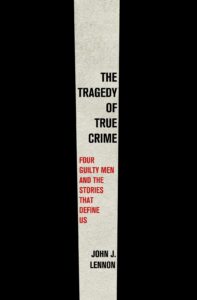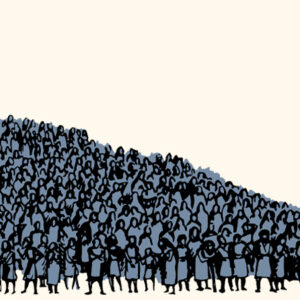
Against True Crime Sensationalism
Prison Journalist John J. Lennon on Exploitative Entertainment and Life in Sing Sing
In November 2016, when I arrived at Sing Sing, the prison was much less intense than Attica. Batons stayed on hips. COs, who were mostly Black and Hispanic, and about half of whom were women, talked to you, not at you, and sometimes even laughed with you. They were from our communities. There was a mean-spiritedness that the white COs up in the mountains had for us that the Black and brown ones who guarded us in Sing Sing did not. When taking the mess hall and yard lists, COs stopped in front of your cell. They didn’t burn us or cut off our electricity out of spite. But Sing Sing was poorly managed, loud and chaotic and loose.
Now, with about fifteen years in prison, I understood what Kenny Shannon, the Irish gangster I’d first met in Sing Sing, had told me when he said I needed to spend some time up in the mountains, in the tough joints like Clinton and Attica, to appreciate the Sing Sing vibe. Like he predicted, I’d also come to see the absurdity of the gangster life I had once aspired to.
In October 2017, Shane and I attended the New York Consortium for Higher Education in Prison at Sing Sing, an event hosted by Hudson Link and Columbia University. Hudson Link’s executive director, Sean Pica, emceed. In 1986, at seventeen years old, Sean, the son of a New York City police officer, shot and killed a friend’s abusive dad after she hired him to do it. He was sentenced to twenty-four years for manslaughter. During his bid, he experienced the harm of the elimination of the federal Pell Grants. John Valverde, who served time with Sean, got out and started Hudson Link, and the organization gave Sean a second chance. He earned a college degree, and when he got out, in 2002, he quickly took over the organization.
For the first time in fifteen years, I wanted time to go slowly because I was enjoying the moment.
Today, Hudson Link operates in six prisons with eleven college partners across New York State. Sean had pull with Sing Sing superintendent, Michael Capra, and was always putting together these wonderful events, like the one Shane and I attended in the visitor area, a low-ceilinged cafeteria room. The chairs were rearranged. Politicians and philanthropists showed up, along with educators who taught in different prisons across the nation. A panel of about five students, including Shane, was slated to speak. A handful of recently released students, continuing their education outside prison, were also on the program.
There was catered food, smart conversation, and networking opportunities. I remember eyeballing the mini Boar’s Head hero sandwiches while another prisoner and I chatted with John B. King Jr., Obama’s education secretary. He was asking us about our class. For the first time in fifteen years, I wanted time to go slowly because I was enjoying the moment. I told Mr. King I had written an op-ed in the Times about college in prison, and he told me he had read it. I would do that a lot back then, plug my own pieces in a sort of desperate attempt to solicit validation. Please, please, please. See me as a writer, see me as anything but a prisoner and a murderer.
The panelists were called to the stage, and the rest of us took our seats. When it was Shane’s turn, he talked about how, in a course on human development, he had learned about “magical thinking.” According to Psychology Today, magical thinking is “the need to believe that one’s hopes and desires can have an effect on how the world turns.”
His point—and he made it well, captivating everyone in the audience—was that when education is available in the darkest corners of society, like these prisons, it offers an opportunity for us to create a new ideal for ourselves, and that, in turn, can not only shift the tone of an institution but also spill over into the material world. Putting the argument into more concrete terms, Shane equated a college education to a vaccine and suggested that people in society “would be remiss not to invest in and further a vaccine that inoculates people with a 98 percent success rate.” He was referring to the low rate of recidivism for formerly incarcerated people who earned college degrees inside.
Then he got more personal: “As the piece of shit who took someone’s life, I understand how my actions brought trauma to my family, friends and community and larger society.”
Prisoners sat among civilians, and it felt so civil. The woman next to me started crying. So did another man in green on the panel. So did the bald man in an expensive suit from the Mellon Foundation. Back then, before I knew anything about Shane’s story, his passion for education and candor about his crime were refreshing. When I learned about him being the first person a New York City prosecutor sought to execute after they reinstated capital punishment in 1995, I couldn’t make sense of that. I realized then that I would write about him.
As Shane came to a new understanding of himself in relation to his crime, it was still difficult to own his trauma and not sound like he was rationalizing what he’d done. While he was having these self-realizations, the public’s understanding of domestic abuse was also changing. Society was starting to accept that abuse creates trauma in people who go on to commit violent crimes.
In 2009, the New York Coalition for Women Prisoners, a group of women who had served time and were still serving time, began lobbying for a bill that would require judges to consider the abuse that many defendants had suffered and weigh how it related to the violent crimes they committed. In the ’90s, about 82 percent of women in New York prisons were severely abused as children, and 75 percent suffered serious abuse by a partner. (No comparable study has been done since.)
Nationally, women’s prisons are a glut of trauma, and the population has grown at twice the rate of men since the ’80s. Today there are about two hundred thousand women behind bars, amounting to nearly the total US prison population in the early ’70s. This bill, called the Domestic Violence Survivors Justice Act, or DVSJA, was getting a lot of momentum. Even though the bill’s language was “gender-neutral,” it was not yet on Shane’s radar.
I couldn’t help thinking about the forces of different kinds of storytelling. During these years, as activists and scholars were trying to change the narrative about the role trauma plays in domestic killings, true crime was entertaining the public with them.
It always jarred me to see joy like that in prison, as if part of our punishment was that we weren’t allowed to feel it.
“From socialites to secretaries, female killers share one thing in common: They all snapped,” Maya Salam wrote for the New York Times in 2023 review, quoting the tagline for the show Snapped. “But what this show delivers cannot be found anywhere else. Each episode explores a crime committed by a woman, crimes you probably would never have heard about otherwise, in part because they happen in America’s nooks and crannies. The stories are largely told through interviews with those involved, often including the criminals or victims themselves. And you get an entire story in about 45 minutes.”
That a New York Times writer would suggest that any forty-five-minute episode of a true crime show could capture the entire story behind a woman’s crime is absurd. Articles like this are one of the reasons I wrote this book. I’m able to come at the story from a different point of view.
On the nights Shane didn’t have college, he attended Rehabilitation Through the Arts, or RTA, the drama program that organized workshops and put on plays like 1776. If they weren’t rehearsing the annual play, the class would be performing some cathartic exercise, much like the ones Shane used to do with the Phoenix Players. I’d be in a college class, maybe on a bathroom break, walking down the hallway, and see him through the door, clapping, laughing. It always jarred me to see joy like that in prison, as if part of our punishment was that we weren’t allowed to feel it. I didn’t. When I smiled, my cheeks twitched.
Shane told me that he felt like this, too. His routine was just a way to distract himself from feeling how he usually felt, which was generally depressed. Many of us in prison are. Shane also attended his Buddhist group, sitting, legs pretzeled, alongside the others and meditating in a basement room in the chapel. On the weekends, he’d stroll down the canopied path, a big piano keyboard tucked under his arm, to the music room in the school building. As I jogged in the A Block yard, I could hear the music spilling out from the caged windows.
Sing Sing was its own world. Some prisoners were in positions of power, given to them by the superintendent, and tasked with organizing coveted events with civilians and catered food. These events were a flash of freedom, so guys were always looking to get their names on the lists. After the education consortium in 2017, I was seldom invited to participate in others. My writing kept me firmly on the administration’s radar. I believe that I was excluded because I was a journalist, someone the superintendent felt that he couldn’t control. To put my name down would bother the man, and the prisoners who organized these events knew this.
Michael Capra had worked his way up the ranks, from guard to superintendent of Sing Sing. He was a roundish, charismatic man. I’d occasionally see him strolling the halls in a pressed suit. Though approachable, he was used to dealing with broken young men. He’d walk by a cell, point his finger at a guy behind the bars, and say, “Enroll in college,” or, “Get your head out of your ass.” Capra embraced the media, but he didn’t embrace me. He relied on a handful of go-to guys in the honor block to speak at these events, where men mingled with the public. The rest of the population called them the Illuminati, and Capra had a nickname, too: “Smile-for-the-Camera Capra.”
These events helped men learn soft skills, like small talk and networking. Shane would sometimes get invites, and over the years he came up with a method called “mentor minute,” in which he would ask a guest, whether it be a professor or documentarian or journalist, for a nugget of wisdom about their work. It helped him imagine who he could become in the world. It hurt that I seldom got an invite to these events. I could’ve practiced my people skills. But I told myself the real stories were back in the cellblocks and yards.
In 2018, the long-form stories I investigated and reported on back in Attica seemed to publish all at once. We had finally received the numbers that backed my hypothesis about the cameras quelling the abuse at Attica. In April, the Marshall Project ran “Spying on Attica,” which Vice co-published. “This Place Is Crazy,” about the mental health crisis in prison, ran in the summer print issue of Esquire.
That same summer, Bill Keller and I wrote a story about a schizophrenic man named Andrew Goldstein who, in 1999, had pushed Kendra Webdale in front of an oncoming subway. The story had two twenty-year arcs: I told Goldstein’s story from the inside; on the outside, Bill unpacked the effects of Kendra’s Law, which helps people with severe mental illness get proper assisted outpatient treatment. In September, “A Turbulent Mind” ran in the Marshall Project and in print in New York magazine.
I asked how she managed to keep the audience interested in stories about the same serial killers. “You gotta trick ’em,” she told me. “Trick ’em into thinking they’re getting new information.”
When I heard that Loen Kelley—the producer who told me that feature magazine writing was unrealistic for a prisoner—was now working at CNN, I figured I’d call her. I wanted to see if she could get me on the network, in a news segment; I saw print journalists doing this all the time after they published important articles. Loen congratulated me on my stories, and we talked for a bit about what she was working on. When I asked about a segment with CNN to talk about the mental health crisis in America’s prisons, Loen leveled with me. “All they want to do on CNN is talk about Trump,” she said. “I’m in the documentary unit. But let me ask around.”
A few days later, a note from Loen on CNN letterhead landed on my cell bars. In it, she wrote that they were “looking for prisoners who would make great interviews for a show with Chris Cuomo.” She didn’t mention the name of the show. “My colleagues are looking for people who will talk candidly and thoughtfully about their lives, about their crimes, and what they’ve learned and how they’ve changed that sort of thing. So if you’re interested—just give my colleague Kim a call. She’ll explain everything!”
I feel foolish reflecting on it all today. Because she’d created that website, PrisonWriters.com, I figured Loen had my best interests in mind. She didn’t. I remember something she mentioned about the HLN documentary she was producing about John Wayne Gacy. I asked how she managed to keep the audience interested in stories about the same serial killers. “You gotta trick ’em,” she told me. “Trick ’em into thinking they’re getting new information.”
I’m hardly the only one who’s been approached by slick true crime producers. Mulumba Kazigo told me what had happened to him. Years before, he was contacted in Sing Sing by a television producer who told him that she wanted to retell his story, the tragedy of it. Mulumba was wary. But after the producer promised Mulumba $1,000, he agreed to participate. It bothered Mulumba to have to always ask his siblings for commissary money. After the film crew interviewed him in Sing Sing, Mulumba never again heard from the producer or received the $1,000. The show aired on Investigation Discovery in 2013, as part of the Blood Relatives series; Mulumba’s episode was called “Paging Doctor Death.”
The show itself is a caricature of true crime: a corny narrator, cringe-worthy B-roll, exoticism, and cheesy music. It’s all to set up the Kazigos as a family in domestic bliss on the cusp of a sudden unraveling: sustained glares from across the dinner table, clenched teeth, orchestral stabs, a shot of blood streaming out from a watering can, and an intense focus on sharp household objects (a shot of Dr. Kazigo holding a kitchen knife). The writing is terrible. After mentioning how one of Mulumba’s siblings had recently committed suicide, the narrator adds ominously: “Little does the family know that another member of this loving household is about to snap.”
For his part, Mulumba is eloquent and soft-spoken. But the episode makes a mockery of what Mulumba and his family went through at the hands of his abusive father. “I thought that was so unethical, the way they could lie to you,” Mulumba told me one evening after class, walking back to our cellblocks. “I didn’t know it was going to be this exploitative thing that would hurt my family even more.”
__________________________________

From The Tragedy of True Crime: Four Guilty Men and the Stories That Define Us by John J. Lennon. Copyright (c) 2025 by the author and reprinted with permission of Celadon Books, a division of Macmillan Publishing Group, LLC.
John J. Lennon
John J. Lennon is serving his twenty-fourth year behind bars, currently in Sing Sing Correctional Facility. His writing has appeared in the New York Review of Books, the New York Times Magazine, the New Yorker, the Atlantic, Esquire, and New York magazine. His work has been anthologized in the Best American Magazine Writing, and he’s twice been a finalist for the National Magazine Award, in feature writing and reviews and criticism. His feature essay “The Apology Letter” was part of the Washington Post Magazine’s special issue that won the National Magazine Award.












